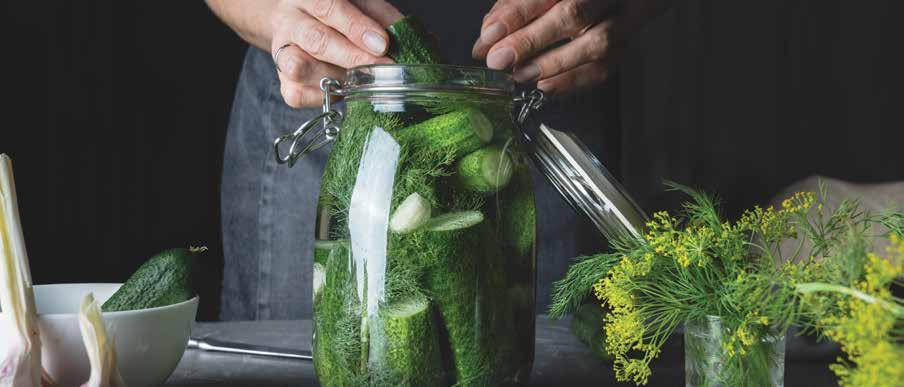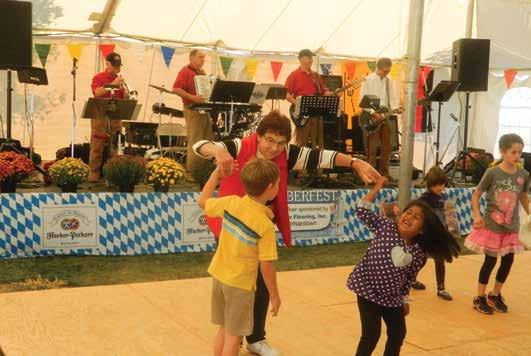
9 minute read
Old Town Innovates While Keeping Tradition Alive
BY DAVID LUHRSSEN
For me, a Serbian salad is one of the most delicious items on any menu in the world. A luscious mound of shredded feta cheese, diced white onions and green peppers and chunks of red tomato, the Serbian salad is a symphony of flavors and colors. Best of all: There is not an ounce of lettuce in sight.
Milwaukee was fortunate for many years to be home to two long-running restaurants serving Serbian salad, Three Brothers and Old Town. Because of the pandemic, Three Brothers is too compact to accommodate in-house dining and can only offer curbside delivery. However, Old Town, housed in a hall as long as a bowling alley, is able to transition into a time of physical distance. The tables have been spread apart, the server wears a mask and the menus are paper throwaways. Otherwise, Old Town continues to afford the ambiance and cuisine that has characterized the South Side restaurant— located under the shadow of St. Josaphat Basilica—for nearly half a century.
Old Town is a family business. Natalia Radicevich gradually assumed responsibility for the restaurant over the past 15 years with the declining health and death of her parents, Alex and Rada, Old Town’s founders. Natalia has tended Old Town like an old-growth tree, deeply rooted yet gradually expanding in new circles. Recent years have seen her adding scrumptious schaum tortes along with wine and brandy pairing dinners and introducing traditional Serbian vegetarian dishes, as well as such nouvelle cuisine touches as a recent special, a salad of paper-thin watermelon slices and feta. But the heart of Old Town’s menu remains grounded in the recipes her family brought to America. Serbia occupies the western point in a culinary zone that treks south through Greece and east through Turkey and Armenia, spreading south from there through the Levant and east again to Persia. Old Town’s honied walnut baclava could be served in fine homes in Beirut and Istanbul; the shish kabob could turn on grills in Cairo and Teheran, albeit the Serbian raznijic is a skewer of pork, a meat not served in many cultures. The demitasse of potent but sweetened black coffee—usually called “Turkish” in America—could be enjoyed as far away as Casablanca.
Fish, Poultry, Pork and Beef
Old Town’s fish special is worth trying when it appears for its cod prepared in a flavorful sauce of tomatoes and green peppers. Lamb is usually on the menu, as are pork, chicken and beef. The cabbage for sarma is specially prepared in casks of brine, and the sauerkraut is less sour than the familiar German version when served alongside an entrée. Chicken pilaf is fine, but why not step up to chicken paprikash with tender breasts simmered in a sauce amply spiced with paprika? It’s attractively served with an array of vegetables that change week by week with availability.
Natalia prizes fresh produce and—let’s not forget—all traditional cuisine was local and farm-to-table. The Serbian variant of burek, a dish of layered phyllo dough filled with spinach, cheese or beef, is the size of a pie and can last for two meals. The Beograd burger is a tasty patty compounded from beef, pork and spices, served in a grilled pita pocket and with—on a recent visit—tender slices of lightly breaded eggplant. Many entrées are $20 or less.
A full bar is available with many unique libations, starting with Eastern European beers, powerful shots of slivovitz (plum brandy), a robust Dalmatian wine and—in the cold season—a hot toddy called Serbian tea.
Old Town’s 1912 building is integral to the charm; a bar room leads into a softly lit, cavernous Mediterranean-plastered hall covered in paintings, objets d’art and artifacts from the Balkans. It’s a step back into memories of an Old World café complete with performing troubadours. Guitarist Jim Waller and multi-string instrumentalist Mike Radicevich, Natalia’s brother, dip into a repertoire of familiar movie themes and melodies spanning the globe from Latin America to the shtetls of Eastern Europe. The crowd claps appreciatively after each number.
To cope with the pandemic, Natalia added curbside delivery while limiting dining-in to Thursdays, Fridays and Saturdays. She hopes to open a sidewalk café in September.
Old Town Serbian Gourmet Restaurant 522 W. Lincoln Ave. | (414) 672-0206 $$-$$$ | Credit Cards: MC, VS Handicap Accessible: Yes (but with one step at the front door)
Canning the harvest should be a joyous and rewarding experience, but if you are in over your head, it can be stressful and overwhelming, even dangerous.
Aspiring or novice canners should not wait for the so-called Harvest Season to get started. Midsummer is a great time to ease into the groove, work on your skills, figure out your game plan and stock up on whatever gear and supplies you don’t have without the pressure of a mountain of produce. If you just do a jar or two here and there, you can keep skin in the game without breaking a sweat.
Where I live, there are several families of Belarusian immigrants from a town called Olshany, which is known for its cucumbers. They are grown in shopping mall-sized greenhouses, some of which are heated by as many as 10 wood stoves. They know about growing cucumbers and have begun selling a small pickling variety that is sweet and juicy enough to eat like popcorn.
Some of the Belarusians sell pickles too, and I bought some with high hopes, but they were disappointing. My friend Val, who was born in Olshany, explained that the pickles for sale at the market aren’t really like the pickles they eat at home, because food safety standards require more salt, vinegar and heat then they care to subject their cucumbers to. “That is why I don’t sell pickles here,” she said.
I had to ask Val what she does at home.
“I put the cucumbers in jars, and I put all the spices. I always do horseradish, dill, parsley, garlic and all kinds of peppers. Put these jars in the oven at 350 for 25 minutes to sanitize them. While I do that, my brine is boiling. I pour the brine into each jar and seal it. Then, I turn the jar over.”
She inverts the pickles twice a day for the next two days, so they spend about half the time upside down. It’s a way of compensating for the fact that she doesn’t boil her pickles, a tactic that makes the pickles more crispy but more dangerous.
Boiling the pickles takes care of any microbes that the salt and vinegar somehow miss. Bacteria or spores can sometimes hide out in air pockets inside dill flowers or elsewhere. Inverting the jars like this ensues the brine makes it everywhere it needs to go.
Her brine recipe—24 cups water, 1 cup salt, 1 cup sugar and 4 cups white vinegar—filled eight jars of cucumber pickles augmented with dill, garlic, crushed red pepper and horseradish leaves, as instructed. Val says the horseradish adds flavor and crispness to the pickles.
I brought a jar of four-day-old pickles to the market. Val opened the jar, stabbed a pickle with her knife and chewed slowly, frowning. “You know, it’s not bad,” she said in a flat Eastern European deadpan.
If you’ve been pickling your whole life like Val, you know the rules well enough to get away with breaking them. But new canners should take a more cautious approach and learn proper safety protocols. Ball Corporation has a book out called Ball Canning Back to Basics. Given it produces virtually all of the canning jars in circulation today, it’s worth reading what the company has to say about how to use its product.
The Ball book begins with a section on the basic gear, ingredients and procedures involved in canning. If you don’t know the importance of adjusting acidity, accounting for altitude or measuring headspace, you should find a reputable source of information like this book or one of the many other educational resources in print and online.

Unsurprisingly, the Ball book’s recipe for dill pickles includes proprietary products like Ball ® Salt and Ball ® Pickle Crisp ® Granules. You can, of course, use any kind of pickling salt. And you can skip those granules or replace them with horseradish leaves— grape, cherry and oak leaves are also widely used for this purpose.
Meanwhile, the Ball recipe calls for “dill sprigs” but doesn’t specify leaves or flowers. According to my sources, dill leaves alone won’t cut it; there have to be flowers. It also calls for cutting of the cucumbers, which you don’t have to do if you pick them small, Belarusian style. Most family recipes start like this, with a proven recipe. Little by little, you make it your own.
Ultimately, there is more than one correct way to can a pickle. One cardinal rule to which every canner abides: If the seal is broken, don’t eat it.
Ari LeVaux has written about food for The Atlantic Online, Outside Online and Alternet.
BALL-STYLE DILLS

Svetlana-Cherruty/iStock/Getty Images Plus via Getty Images
INGREDIENTS
4 pounds (3- to 5-inch) pickling cucumbers
1 gallon plus 1 quart water
10 tablespoons Ball Salt for Pickling and Preserving
3 cups white vinegar (5% acidity)
2 tablespoons sugar
1 tablespoon pickling spice
12 dill sprigs
2 tablespoons mustard seeds
Ball Pickle Crisp Granules (optional)
DIRECTIONS
Rinse the cucumbers under cold running water and trim any that are longer than 5 inches so that they’ll fit comfortably in the jar. Cut each cucumber lengthwise into quarters. Place the spears in a large, clean container (such as a 12- to 18-quart, food-safe, plastic pail or basin). Combine 1 gallon of the water and 6 tablespoons of the salt in a large pitcher, stirring until the salt dissolves. Pour over the cucumbers; cover and let stand at room temperature for 24 hours. Drain, rinse under cold running water and drain.
Combine the remaining 1 quart water, vinegar, sugar, pickling spice and remaining 1⁄4 cup salt in a stainless steel or enameled saucepan. Bring to a boil, stirring until the salt and sugar dissolve.
Place 2 of the dill sprigs and 1 teaspoon of the mustard seeds into a hot, freshly sterilized jar, and pack tightly with the cucumber spears. Ladle the hot pickling liquid over the spears, leaving a 1⁄2- inch headspace. Add 1⁄8 teaspoon Ball Pickle Crisp Granules to jar, if desired. Remove air bubbles. Wipe the jar rim. Center the lid on the jar. Apply the band and adjust to fingertip tight. Place the jar in a boiling water canner. Repeat until all the jars are filled.
Process the jars 10 minutes, adjusting for altitude. Turn off heat; remove the pot’s lid, and let the jars stand 5 minutes. Remove the jars and cool.














